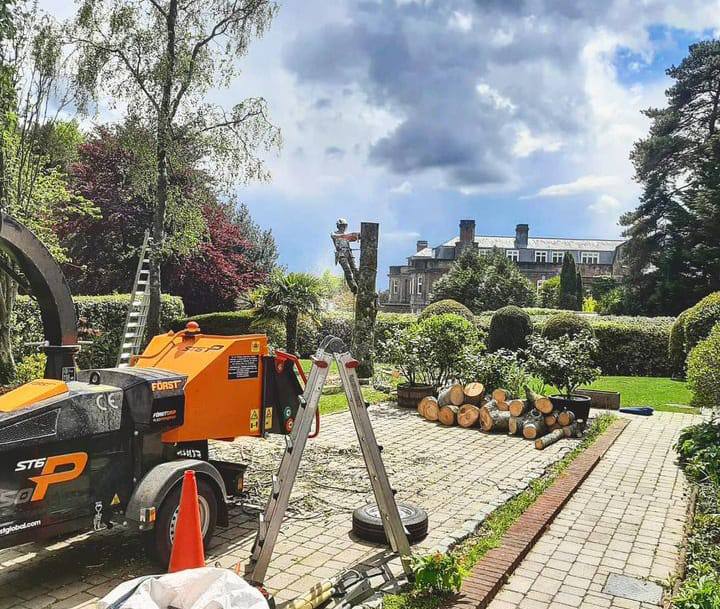Crown Reduction for Shaded Lawns and Dying Underplanting
A mature tree in your garden can be a beautiful feature, offering structure, character, and shade. However, excessive shade from a dense or oversized canopy can quickly become a problem — particularly for lawns and underplanting that struggle to survive beneath it. If you’re dealing with patchy grass, leggy plants or a lack of light reaching your garden beds, crown reduction could be the solution. At Stapleford Tree Surgeons, we provide expert crown reduction services throughout Stapleford, Nottingham, helping clients restore balance between tree health and garden vitality.
In this article, we’ll explain what crown reduction is, how it benefits shaded lawns and underplanting, and why it’s a practical, professional choice for light management in your outdoor space.
What Is Crown Reduction?
Crown reduction is a selective pruning technique that reduces the overall size of a tree’s canopy. Rather than cutting the tree back harshly, this method focuses on reducing the length of individual branches — particularly those contributing to excessive height or spread — while maintaining the tree’s natural shape and structural integrity.
It’s a skilled process that requires an understanding of tree growth patterns, biology, and balance. Done correctly, it can enhance a tree’s appearance, safety, and interaction with its surrounding environment.
How Excessive Shade Affects Lawns and Underplanting
When a tree canopy becomes too large or too dense, it blocks essential light and rainfall from reaching the ground below. Over time, this can cause:
Patchy or Thinning Lawns
- Grass needs adequate sunlight for healthy photosynthesis. Too much shade can lead to weak, sparse, or moss-filled lawns.
- Lawns that were once lush may decline, particularly under large deciduous or evergreen trees.
Poor Underplanting Growth
- Many shrubs and perennials require dappled or partial sunlight to thrive.
- Without enough light, plants may become leggy, fail to flower, or die off altogether.
Increased Moisture Retention
- Heavy shade can prevent ground areas from drying out, creating damp, poorly ventilated soil.
- This encourages fungal growth and root rot in some plant species.
Restricted Airflow
- A thick canopy can trap humidity and reduce airflow, making the microclimate beneath the tree more prone to disease and pest issues.
Benefits of Crown Reduction for Garden Light Management
Crown reduction offers an effective, tree-friendly way to manage excess shade without removing the tree entirely.
1. Improved Light Penetration
- By reducing the volume of the canopy, more natural light can reach the lawn and underplanting below.
- This helps revitalise struggling grass and encourages stronger plant growth.
2. Healthier Lawn Conditions
- Better access to sunlight supports thicker, greener turf.
- Enhanced airflow helps dry out damp ground, reducing moss and mildew.
3. Preserved Tree Health and Appearance
- Unlike topping (a damaging and unsightly method), crown reduction maintains the tree’s shape and health.
- Selective pruning reduces wind resistance and potential for limb failure.
4. Encouragement of Sustainable Planting
- With more light and space, you can establish a greater variety of plants below the tree.
- This creates a healthier, more diverse garden environment.
When to Consider Crown Reduction
You may benefit from crown reduction if:
- Your lawn is thinning or moss-ridden under the tree
- Existing plants are dying off or failing to thrive
- Your garden feels overly shaded or closed-in
- You want to open up views while retaining tree coverage
- There are low-hanging limbs creating unwanted shade or obstruction
At Stapleford Tree Surgeons, we assess each case individually, considering the species, age, condition, and location of the tree before carrying out any reduction work.
Timing and Technique
Crown reduction is best carried out during the dormant season (late autumn to early spring), although this can vary depending on the species. Certain trees are more tolerant of reduction than others — for example:
- Oak, hornbeam, and lime respond well to careful reduction.
- Conifers and some evergreens require more conservative cuts.
We ensure all cuts are made at appropriate growth points to promote healthy regrowth and reduce the risk of disease or decay. Our team uses BS3998 standards for tree work to ensure quality and consistency.
Why Choose Stapleford Tree Surgeons?
Operating throughout Stapleford, Nottingham, Stapleford Tree Surgeons are trusted experts in crown reduction and all aspects of tree care. Our approach is always guided by:
- A commitment to tree health and garden ecology
- Careful, site-specific assessment and planning
- Skilled execution using industry-standard equipment
- Full clean-up and responsible green waste disposal
Whether you need to brighten a shaded lawn, support underplanting, or reshape an overgrown canopy, we offer professional solutions with long-term value.
Conclusion
Crown reduction is a highly effective and environmentally sensitive way to manage excess shade in your garden. By carefully reducing the canopy of an established tree, you can revitalise lawns, improve plant health, and create a more balanced and enjoyable outdoor space — all without sacrificing the beauty of the tree itself.
If you’re based in Stapleford, Nottingham and your garden is suffering from heavy shade or declining plant life beneath a tree, contact Stapleford Tree Surgeons. We’re here to help you restore light, life, and harmony to your landscape with expert tree care tailored to your needs.
Call us on: 0115 647 1191
Click here to find out more about Stapleford Tree Surgeons
Click here to complete our contact form and see how we can help with your tree’s needs.

